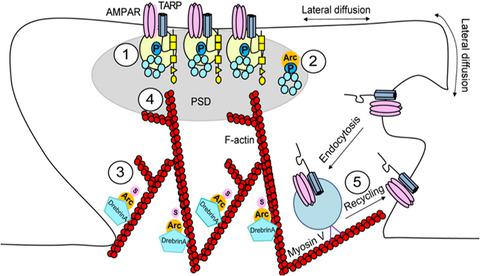当前位置:
X-MOL 学术
›
Eur. J. Nerosci.
›
论文详情
Our official English website, www.x-mol.net, welcomes your feedback! (Note: you will need to create a separate account there.)
Arc/Arg3.1 function in long-term synaptic plasticity: Emerging mechanisms and unresolved issues
European Journal of Neroscience ( IF 3.4 ) Pub Date : 2020-09-05 , DOI: 10.1111/ejn.14958 Hongyu Zhang 1 , Clive R Bramham 1
European Journal of Neroscience ( IF 3.4 ) Pub Date : 2020-09-05 , DOI: 10.1111/ejn.14958 Hongyu Zhang 1 , Clive R Bramham 1
Affiliation

|
Arc (activity-regulated cytoskeleton-associated protein) is posited as a critical regulator of long-term synaptic plasticity at excitatory synapses, including long-term potentiation, long-term depression, inverse synaptic tagging and homoeostatic scaling, with pivotal roles in memory and postnatal cortical development. However, the mechanisms underlying the bidirectional regulation of synaptic strength are poorly understood. Here we review evidence from different plasticity paradigms, highlight outstanding issues and discuss stimulus-specific mechanisms that dictate Arc function. We propose a model in which Arc bidirectionally controls synaptic strength by coordinate regulation of AMPA-type glutamate receptor (AMPAR) trafficking and actin cytoskeletal dynamics in dendritic spines. Key to this model, Arc is proposed to function as an activity-dependent regulator of AMPAR lateral membrane diffusion and trapping at synapses.
中文翻译:

Arc/Arg3.1 在长期突触可塑性中的功能:新兴机制和未解决的问题
Arc(活性调节的细胞骨架相关蛋白)被认为是兴奋性突触长期突触可塑性的关键调节因子,包括长期增强、长期抑制、反向突触标记和稳态缩放,在记忆和产后皮质发育。然而,对突触强度双向调节的潜在机制知之甚少。在这里,我们回顾来自不同可塑性范式的证据,突出突出问题并讨论决定 Arc 函数的刺激特定机制。我们提出了一个模型,其中 Arc 通过协调调节 AMPA 型谷氨酸受体 (AMPAR) 运输和树突棘中的肌动蛋白细胞骨架动力学来双向控制突触强度。这个模型的关键,
更新日期:2020-09-05
中文翻译:

Arc/Arg3.1 在长期突触可塑性中的功能:新兴机制和未解决的问题
Arc(活性调节的细胞骨架相关蛋白)被认为是兴奋性突触长期突触可塑性的关键调节因子,包括长期增强、长期抑制、反向突触标记和稳态缩放,在记忆和产后皮质发育。然而,对突触强度双向调节的潜在机制知之甚少。在这里,我们回顾来自不同可塑性范式的证据,突出突出问题并讨论决定 Arc 函数的刺激特定机制。我们提出了一个模型,其中 Arc 通过协调调节 AMPA 型谷氨酸受体 (AMPAR) 运输和树突棘中的肌动蛋白细胞骨架动力学来双向控制突触强度。这个模型的关键,



























 京公网安备 11010802027423号
京公网安备 11010802027423号